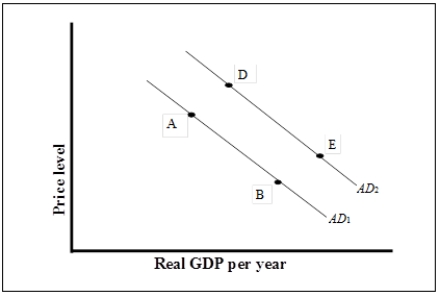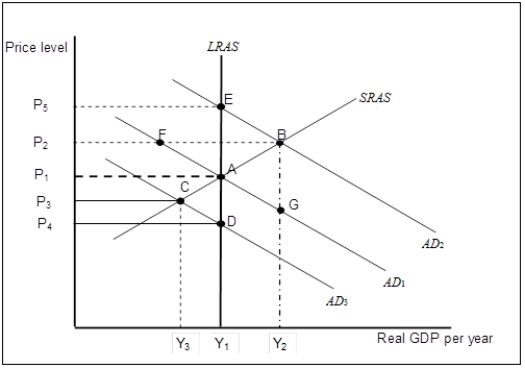A) An increase in consumer wealth
B) An increase in the amount of investment demanded by firms at each price level
C) An increase in an economy's price level
D) An increase in the price level of a foreign economy
Correct Answer

verified
Correct Answer
verified
True/False
In the long run, real output can be less than, equal to, or greater than the economy's potential output.
Correct Answer

verified
Correct Answer
verified
Multiple Choice
All the following explain price stickiness except
A) firms choose not to adjust prices until they can assess if changes in sales are temporary or permanent.
B) the more firms produce, the lower the average cost of production.Therefore, firms are willing to not raise prices as long as they can sell more.
C) firms may be concerned that consumers may be angered by price increases.
D) firms may be concerned that their rivals may not match their price increases.
Correct Answer

verified
Correct Answer
verified
Multiple Choice
During the recession of 2001, the leftward shifts in aggregate demand and aggregate supply that occurred at that time necessarily reduced
A) real GDP only.
B) the price level only.
C) real GDP and the price level.
D) potential output.
Correct Answer

verified
Correct Answer
verified
Multiple Choice
Which of the following statements is true of the economy in the long run? In the long run, I.real GDP eventually moves to potential output because all wages and prices are assumed to be flexible. II.the economy can achieve its natural level of employment and potential output at any price level. III.there is no cyclical unemployment.
A) I only
B) I and II only
C) I and III only
D) I, II, and III
Correct Answer

verified
Correct Answer
verified
True/False
The short run in macroeconomics is a period in which wages and some other prices are sticky.
Correct Answer

verified
Correct Answer
verified
Multiple Choice
A graph that depicts the relationship between the total quantity of goods and services demanded and the price level is the
A) aggregate demand curve.
B) average price level.
C) circular flow model.
D) GDP curve.
Correct Answer

verified
Correct Answer
verified
True/False
Taking no action and allowing an economy to adjust by itself is called a nonintervention policy.
Correct Answer

verified
Correct Answer
verified
Multiple Choice
Use the following to answer questions
Exhibit: Aggregate Demand  -(Exhibit: Aggregate Demand)
What could have caused a movement from point D to point A?
-(Exhibit: Aggregate Demand)
What could have caused a movement from point D to point A?
A) An increase in the economy's general price level
B) A decrease in investment demand due to lower expected sales
C) A decrease in capital gains taxes
D) An increase in money supply that lowers interest rate
Correct Answer

verified
Correct Answer
verified
True/False
An increase in the prices of natural resources will lead to a decrease in short-run aggregate supply.
Correct Answer

verified
Correct Answer
verified
Multiple Choice
Suppose the economy is initially in long-run equilibrium.Which of the following events leads to an increase in the price level and a decrease in real GDP in the short run?
A) A decrease in health insurance premiums paid by firms raises the cost of employing labor
B) An increase in government transfer payments
C) An increase in the cost of a key input such as oil
D) A sharp fall in stock market prices
Correct Answer

verified
Correct Answer
verified
Multiple Choice
Which of the following is a source of wage stickiness? I.fixed wage contracts II.minimum wage laws III.workers and firms want to avoid complexity of negotiating contracts frequently
A) I only
B) I and II only
C) I and III only
D) I, II, and III
Correct Answer

verified
Correct Answer
verified
Multiple Choice
Suppose the price of an important natural resource such as oil falls.What will be the effect on the short-run aggregate supply curve?
A) There will be movement to the left, along the aggregate supply curve.
B) The aggregate supply curve will shift to the left.
C) There will be movement to the right, along the aggregate supply curve.
D) The aggregate supply curve will shift to the right.
Correct Answer

verified
Correct Answer
verified
Multiple Choice
All other things unchanged, an increase in exports relative to imports will
A) cause a movement upward along a given aggregate demand curve.
B) cause a movement downward along a given aggregate demand curve.
C) shift the aggregate demand curve to the right.
D) shift the aggregate demand curve to the left.
Correct Answer

verified
Correct Answer
verified
Multiple Choice
An increase in aggregate demand, all other things unchanged, in the long run will generate
A) an increase in potential output and no change in the price level.
B) a decrease in potential output and no change in the price level.
C) no change in potential output and an increase in the price level.
D) no change in potential output and a decrease in the price level.
Correct Answer

verified
Correct Answer
verified
Multiple Choice
Use the following to answer questions
Exhibit: Long-run Equilibrium  -(Exhibit: Long-run Equilibrium)
Changes in aggregate demand from AD1 to either AD2 or AD3
-(Exhibit: Long-run Equilibrium)
Changes in aggregate demand from AD1 to either AD2 or AD3
A) will change nominal GDP but will not change real GDP in the long run.
B) will change real GDP but will not change nominal GDP in the long run.
C) will change the potential level of real GDP.
D) will change the price level and real GDP.
Correct Answer

verified
Correct Answer
verified
Multiple Choice
In the long run, a decrease in aggregate demand, all other things unchanged, will cause the price level to
A) increase and potential output to increase.
B) decrease and potential output to decrease.
C) increase and potential output to remain stable.
D) decrease and potential output to remain stable.
Correct Answer

verified
Correct Answer
verified
Multiple Choice
Use the following to answer questions
Exhibit: Short-run Aggregate Supply  -(Exhibit: Short-run Aggregate Supply)
Suppose that the economy is in long-run equilibrium at point A.Now suppose net exports increase.As a result of this,
-(Exhibit: Short-run Aggregate Supply)
Suppose that the economy is in long-run equilibrium at point A.Now suppose net exports increase.As a result of this,
A) real GDP is temporarily above potential output.
B) the economy's potential output increases to Y2.
C) the economy moves to a new long-run equilibrium at point B.
D) there is some cyclical unemployment.
Correct Answer

verified
Correct Answer
verified
Multiple Choice
What happens in the domestic economy when there is an increase in foreign prices, all other things unchanged?
A) Net exports and aggregate demand fall.
B) Net exports fall and aggregate demand increases.
C) Net exports and aggregate demand increase.
D) Net exports rise and aggregate demand falls.
Correct Answer

verified
Correct Answer
verified
Multiple Choice
What is the difference between a change in aggregate demand and a change in aggregate quantity of real GDP demanded?
A) A change in aggregate demand is represented by a movement along the aggregate demand curve in response to a price change while a change in aggregate quantity of real GDP demanded is represented by a shift of the aggregate supply curve in response to a change in a component of aggregate demand.
B) A change in aggregate demand is represented by a shift of the aggregate demand curve in response to a change in the actual price level while a change in aggregate quantity of real GDP demanded is represented by a movement along the aggregate demand curve in response to a change in the expected price level.
C) A change in aggregate demand is represented by a shift of the aggregate demand curve in response to a change in a component of aggregate demand while a change in aggregate quantity of real GDP demanded is represented by a movement along the aggregate demand curve in response to a change in the price level.
D) There is no difference between the two terms.
Correct Answer

verified
Correct Answer
verified
Showing 101 - 120 of 162
Related Exams